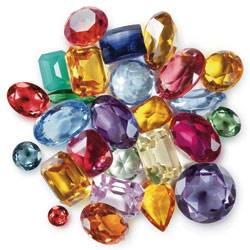|
Feature Stories
Articles from PEARL JEWELLERY (380 Articles), GEMSTONES - LOOSE (254 Articles), GEMSTONES - SYNTHETIC (54 Articles)

Coloured gems
Common misconceptions in gem nomenclature
 2.8 k views | Posted May 01, 2011 2.8 k views | Posted May 01, 2011 | By Lorna Goodyer
CIBJO provides definitive guidelines on gem nomenclature, yet misnomers are still rife. Lorna Goodyer talks to gemmology expert Ronnie Bauer to find the top offenders.
THE OLD SYNTHETIC DEBATE
Ever since there have been jewellery-quality synthetic gemstones there has been raging debate over what to call them. Thousands of carats of man-made diamonds have entered the global market yet confusion over the term synthetic still exists – both at a retail and supplier level – and the issue remains controversial.
CIBJO guidelines state that man-made diamonds – which are identical in chemical and physical structure to their mined counterparts – must be described using the prefixes “synthetic”, “laboratory-created” or “laboratory-grown”. Any other terminology calls into question the issue of disclosure and is strictly against CIBJO’s ruling – and subsequently the guidance of both the Gemmological Association of Australia (GAA) and Jewellers Association of Australia (JAA).
CIBJO joint communications director Ya’akov Almor says, “Synthetic designates an exact copy – made by man – of a natural product, down to the chemical and physical structure.” He laments the fact that this term is used in a misleading way in other industries to denote a product that is a simulant – something that merely imitates the original. He partly attributes the public’s misunderstanding of ‘synthetic’ (and hence many jewellers’ continuing reluctance to use the CIBJO-approved term) to this widespread misuse.
At CIBJO’s annual congress this March, it was agreed the Gemstone Blue Book would be brought in line with the Diamond Blue Book, which last year voted to include “laboratory-created” and laboratory-grown” as acceptable alternatives to the term “synthetic”. Ronnie Bauer, who is the GAA’s representative to CIBJO, stresses that jewellery retailers need to also be aware that manipulation of these prefixes is against CIBJO guidance. “You can’t just say it’s a ‘grown’ ruby – you need to use the word ‘laboratory-grown’; you can’t use half the name,” he explains.
The GAA and CIBJO also highlight the term ‘cultured’ as one that it has seen misused in gemmological terminology. Quite simply, Bauer says, “This is not even a misnomer – it is an illegal term.” Jewellers need to be clear that the term ‘cultured’ can only be used in reference to pearls.
ENHANCED GEMS AND QUALIFIERS
Gems that have been treated to enhance their looks are still natural stones, but they are treated natural stones and need to be described using the appropriate qualifier. Unfortunately, this hasn’t always been adhered to and the GAA has found itself fighting a constant battle over disclosure. Bauer says glass-filled ruby is one area of confusion and cites a recent incident with Pandora as a “classic example” of where some jewellery companies are trying to market a treated stone with a “fancy misnomer”. “Nobody has accepted the terminology Pandora has used for glass-filled ruby, which they’re trying to rebrand as treated pink sapphire,” he says. “There are certain recognised, acceptable terms for these things. The accepted term is what’s got to be used.” In this case, because the gemstone is corundum with a chromium colouring (which is what makes it red/pink), it must be called ruby.
Bauer says it is important to disclose glass-filled ruby in the appropriate way in order to protect the consumer. “The name ‘ruby’ means something and if it starts to be compromised with fillers, etc, to the point that the gem loses its integrity, then the industry will have a crisis of confidence with one of its ’flagship‘ gems,” he claims.
TREACHEROUS TERMINOLOGY
Like ruby, other gems have fallen prey to name changes. Most of the time this is because one term is considered more attractive to buyers than another. Some switches are more serious cases of descriptor misuse than others:
• “Australian jade” vs chrysoprase In the East, Australian chrysoprase – a quartz coloured by nickel – is sold as “Australian jade”. The jade that chrysoprase imitates is an entirely different mineral that is coloured by chromium and called jadite. Similarly, the mineral bowenite serpentine can be easily mistaken for jade at first glance. Bauer says, “The Asians are keen to apply the word jade to anything that appears green because the word ‘jade’ commands a much better price.”
• Citrine vs topaz These are completely different gems, yet the cheaper stone (citrine) is often used as an imitant for the more expensive, but similar looking, yellow topaz gem. “It can look like a topaz, so they call it topaz, but it’s nothing like it,” says Bauer. “It hasn’t got the same hardness, it hasn’t got the same chemical formula. It hasn’t even got the same crystal structure.”
• Paraiba tourmaline There is one species of tourmaline only found in Paraiba, Brazil, which is coloured by copper. “Because of the value of the paraiba, unscrupulous dealers are selling anything that looks like a blue and bluish green tourmaline as a paraiba,” Bauer complains. “We have on occasions had to do advanced spectra analysis work on tourmalines to prove to clients that their tourmaline is not a paraiba tourmaline.”
• Alexandrite The natural red/green colour change gem is rare and consequently pricey. But the synthetic stone often sold in retail stores as alexandrite is dirt cheap to produce and not the same thing. “There’s alexandrite and then there’s synthetic corundum imitating alexandrite – and there’s a plethora of that material out there,” warns Bauer. The chemical properties of corundum and chrysoberyl (the scientific name for alexandrite) are completely different.
PRECIOUS VS SEMI-PRECIOUS
Do you know which gemstones are classified as semi-precious these days? The answer is none. CIBJO removed the term from the Gemstone Blue Book’s accepted terminology two years ago, but it’s clear that many jewellers and suppliers have yet to catch up.
The Blue Book calls the term “misleading”, and Bauer says this is because “everything costs money these days – it just depends where you set your dollar value point”. For example, he explains, “A demantoid garnet can be infinitely more valuable than a poor-quality diamond. So to call it ‘semi-precious’ demeans the quality of the gem – it makes for a ‘them and us’ attitude.”
PEARLS OF WISDOM?
Bauer says the biggest misnomer for pearls at present surrounds the interpretation of the term Keshi pearl by some dealers: “Is a Keshi a natural pearl?” This type of pearl is a natural by-product of the culturing process – it only occurs as a result of the human intervention that is the placing of a bead into the oyster – unlike the formation of a natural pearl, where there is strictly no human intervention. “There’s a definite difference between the two,” Bauer explains, adding that the distinction is important because, like ruby, the preciousness of the natural pearl needs to be protected.
CIBJO’s Blue Books can be downloaded at www.cibjo.org.
|
|
|
|